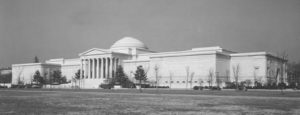Controls for the National Gallery of Art
Johnson Service Company climate controls help protect national art treasures
May 16, 1939 (PD: 201711)
The May 16, 1939 edition of The Milwaukee Sentinel reported on the Johnson Service Company’s (Johnson Controls’ former name) controls contract for the new National Gallery of Art under construction in Washington, D. C. The Company was to fabricate all of the temperature and humidity control devices used throughout the Gallery, which was to house one of the world’s most impressive assemblages of art, including the Andrew Mellon collection valued at $50 million.
Company president Joseph Cutler remarked that control of humidity and temperature in the building was “extremely important,” not only from the viewpoint of visitor comfort, but for the preservation of the paintings, bronze sculptures, and other artworks that can deteriorate under varying atmospheric conditions.
The National Gallery of Art was created for the people of the United States by a joint resolution of Congress to accept the gift of financier and art collector Andrew Mellon in January 1937. In the 1920s, Mellon began assembling his art collection with the idea of eventually donating it as the core of a national art museum.
Funds to construct the building to house the collection were provided by the A. W. Mellon Educational and Charitable Trust. Situated on the National Mall, the neo-classical building was designed by John Russell Pope, who would later design the Jefferson Memorial in Washington, D. C. At the time of its completion, it was the largest marble structure in the world.
On March 17, 1941, President Franklin D. Roosevelt accepted the completed building and the collections on behalf of the people of the United States of America. In 1978, the Gallery added a second building and, in 1999, added a sculpture garden to house its ever-growing collection. The Gallery is open to the public free of charge and played host to 4.6 million visitors in 2009.


